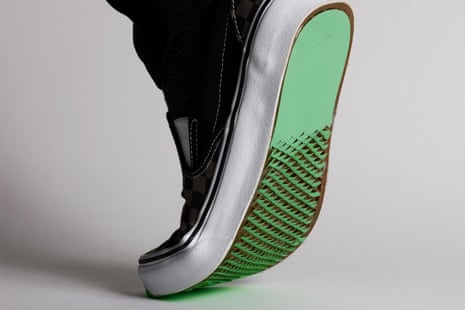The Japanese art of paper cutting and folding, or kirigami, has led to mind-bending 3D structures from 2D sheets, including spectacular pop-up designs. But now researchers have been getting to grips with the technique for a very down-to-earth reason: creating non-slip shoes.
Scientists have revealed they have developed a kirigami-inspired sole, where tiny spikes pop up from its surface as the shoe is bent during walking. The team found the spikes enhance grip, which could help prevent potentially fatal falls.
“What we are trying to do is augment, or add on, to [existing systems like studs or rubber soles] to have a better grip on slippery surfaces, whether it be ice or whether it be oily surfaces in certain occupations,” said Dr Giovanni Traverso of the Massachusetts Institute of Technology in the US.
Traverso added that the kirigami system drew inspiration from friction-enhancing features found in nature, such as the semi-retractable claws of cheetahs that help them chase prey, or the scales on snakes that can be orientated to help them slither along.
“They are dynamic, they are not static structures,” said Traverso. “Walking is a dynamic process so we wanted to develop a system that was also dynamic and could respond to movement.”
Writing in the journal Nature Biomedical Engineering, the team describe how they applied kirigami techniques to sheets of stainless steel using a laser cutter. After carrying out simulations, the team settled on three different patterns: a regular array of semi-circular cuts, triangular cuts and cuts shaped like curved thorns.
The team tested the patches on surfaces including ice, vinyl and hardwood, finding that, on all materials, the various patterned patches, when buckled, increased friction compared with patches of smooth stainless steel, with the curved thorn pattern showing the best performance on ice.
Patches of the latter were then fixed to the front half of regular rubber-soled shoes worn by participants. While at rest, the surface of the sole remained flat; however, as the sole of the shoe was buckled when the wearer lifted their heel – the “toe-off” stage of a step – an array of needle-like spikes popped out of the stainless steel patch under the front of the shoe, increasing friction further.
Dr Sahab Babaee, first author of the research, said the system offered about 20-35% higher friction than shoes or boots with gripping elements on their soles. “By adding [dimpling to the sole] and combining with kirigami needles, we expect to observe further friction enhancement, [above] 35%,” he said.
Prof Katia Bertoldi, another author of the research from Harvard University, told the Guardian the approach was simple, yet effective. “You introduce some cuts in a certain way and then you get this behaviour that is so simple but then can also be exploited for some functionality, [that] can help people,” she said.
The team say they are now working to develop the patches, adding the work could lead to a whole new type of shoe.
“We see this either as an add-on or it could be incorporated into the sole directly,” said Traverso. “We hope that [people] can rush out and buy these soon, and that is what we are working towards.”
